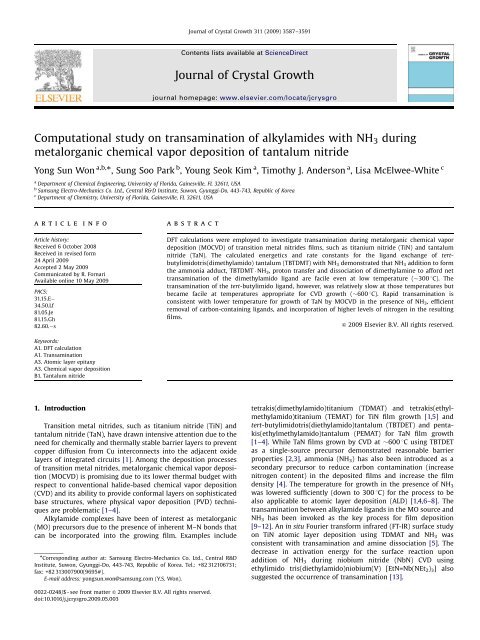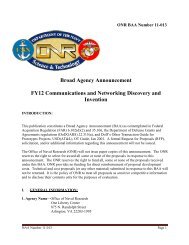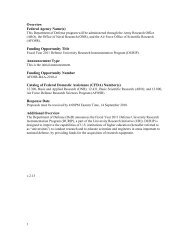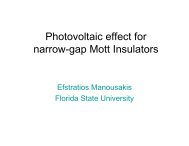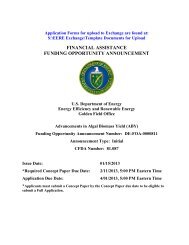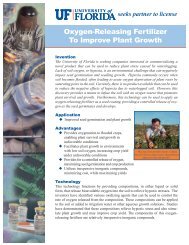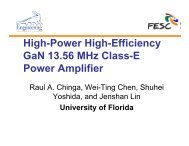Computational study on transamination of alkylamides with NH3 ...
Computational study on transamination of alkylamides with NH3 ...
Computational study on transamination of alkylamides with NH3 ...
Create successful ePaper yourself
Turn your PDF publications into a flip-book with our unique Google optimized e-Paper software.
ARTICLE IN PRESSY.S. W<strong>on</strong> et al. / Journal <strong>of</strong> Crystal Growth 311 (2009) 3587–3591 35892p+Dimethylamine2t42.4 ‡TS42.427.6Intermediate2i28.9 ‡ 56.5TBTDMT0.0Fig. 2. Calculated energetics <strong>of</strong> the b-hydride eliminati<strong>on</strong> <strong>of</strong> TBTDMT to generate Ta(MeNCH 2 )(NMe 2 )[(N(t-Bu)]. Energies are reported in kcal/mol.3t-a9.43p-aTSTBTDMT+ NH 312.1 ‡+0.0TBTDMT•NH 3 - 2.7 - 3.0Dimethylamine3t-b23t-b1TS231.2TS119.83i-b31.53p-bTBTDMT+ NH 30.022.5TBTDMT•NH 3Intermediate -0.3- 2.72.4+t-butylamineFig. 3. Calculated energetics <strong>of</strong> the transaminati<strong>on</strong> <strong>of</strong> a dimethylamido ligand (a) and tert-butylamido ligand (b) <strong>of</strong> TBTDMT <strong>with</strong> NH 3 . Energies are reported in kcal/mol.Table 1Calculated rate c<strong>on</strong>stants for selected individual steps in the decompositi<strong>on</strong> <strong>of</strong>TBTDMT at different temperatures.Entry Reacti<strong>on</strong>saE a ln A a k(s 1 )(kcal/mol)25 1C 3001C 6001C1 TBTDMT-2t 36.7 18.4 2.7 10 19 9.5 10 8 0.42 TBTDMT NH 3 -3t-a 13.2 30.1 2.5 10 3 1.2 10 8 5.6 10 93 TBTDMT NH 3 -3t-b1 23.7 30.2 5.1 10 5 1.2 10 4 1.4 10 74 3i-b-3t-b2 32.2 33.4 7.6 10 10 1.6 10 2 2.8 10 6a E aand A are the activati<strong>on</strong> energy and pre-exp<strong>on</strong>ential factor in theArrhenius form, k=A exp( E a /RT), obtained from the plot <strong>of</strong> the calculated ratec<strong>on</strong>stant vs. temperature.order <strong>of</strong> magnitude even at an elevated temperature <strong>of</strong> 600 1C. Inc<strong>on</strong>trast, the dimethylamido ligand exchange was calculated to bekinetically competent for film growth, while tert-butylimidoligand exchange was significantly slower due to its relativelyhigher barrier (Fig. 3b).These calculati<strong>on</strong>s are c<strong>on</strong>sistent <strong>with</strong> a switch to a transaminati<strong>on</strong>pathway lowering the growth temperature when TBTDETwas used in the presence <strong>of</strong> NH 3 (growth at 300–375 1C, comparedto 500–650 1C <strong>with</strong> TBTDET as a single-source precursor) andexplains the efficient removal <strong>of</strong> carb<strong>on</strong>-c<strong>on</strong>taining ligands in thepresence <strong>of</strong> NH 3 compared to the facilitated carb<strong>on</strong> incorporati<strong>on</strong>in the deposited films via a self-decompositi<strong>on</strong> pathway (Fig. 2)[2–4,24–26]. Similar reacti<strong>on</strong>s are likely to be involved in the use
ARTICLE IN PRESS3590Y.S. W<strong>on</strong> et al. / Journal <strong>of</strong> Crystal Growth 311 (2009) 3587–3591N2Selected b<strong>on</strong>d lengths and angles4. C<strong>on</strong>clusi<strong>on</strong>sN1TaTa-N1 (Å) 2.00 (avg.)Ta-N2 ( Å) 1.78N1-Ta-N2 ( ° ) 109.35 (avg.)ΔH ° 298 (kcal/mol)Ta-N1 93.0Ta-N2 138.9Fig. 4. Optimized geometry <strong>of</strong> Ta(NH 2 ) 3 (NH) following complete transaminati<strong>on</strong>.N1 denotes nitrogen in the amido ligand and N2 denotes nitrogen in the imidoligand.<strong>of</strong> related precursors <strong>with</strong> NH 3 in TaN ALD executed at even lowertemperature (250 1C) [1,6–8]. However, the relatively higherbarrier for the eliminati<strong>on</strong> <strong>of</strong> tert-butylamine via transaminati<strong>on</strong>is c<strong>on</strong>sistent <strong>with</strong> the observati<strong>on</strong> <strong>of</strong> residual carb<strong>on</strong> c<strong>on</strong>tent(15 at%) in the TaN ALD films using TBTDET and NH 3 at 250 1C[1,8]. The lack <strong>of</strong> difference in the carb<strong>on</strong> c<strong>on</strong>tent (15 at%) in theALD films using the same MO source (TBTDET) <strong>with</strong> H 2 plasma[1,8] also indirectly supports the slower transaminati<strong>on</strong> <strong>of</strong> tertbutylimidoligand as a cause <strong>of</strong> residual carb<strong>on</strong>. ALD experimentsusing PEMAT and NH 3 , in c<strong>on</strong>trast, produced much lower carb<strong>on</strong>c<strong>on</strong>tent (7–8 at%) in the deposited films 1 because the fiveequivalent alkylamido ligands <strong>of</strong> PEMAT are exchanged easilyvia transaminati<strong>on</strong> <strong>with</strong> NH 3 .To evaluate how Ta–N b<strong>on</strong>ds were affected by transaminati<strong>on</strong>,the optimized geometry <strong>of</strong> the (NH 3 ) 3 Ta(NH), in which all theligands have been exchanged via transaminati<strong>on</strong>, and its calculatedb<strong>on</strong>d dissociati<strong>on</strong> enthalpies are shown in Fig. 4. Theincrease <strong>of</strong> b<strong>on</strong>d dissociati<strong>on</strong> enthalpies by 12–16 kcal/mol up<strong>on</strong>transaminati<strong>on</strong> is c<strong>on</strong>sistent <strong>with</strong> survival <strong>of</strong> the imido ‘‘Ta–N’’fragment (Ta–N2 in Fig. 4) during depositi<strong>on</strong> but the str<strong>on</strong>geramido Ta–N b<strong>on</strong>ds (Ta–N1 in Fig. 4) could also have a greatertendency to be carried <strong>on</strong> the film depositi<strong>on</strong>. A dielectric TaN xfilm (x41, e.g., Ta 3 N 5 ) <strong>with</strong> very high resistivity would then bemore likely to result if amm<strong>on</strong>ia is employed [2,9,10]. The nature<strong>of</strong> TaN x has been c<strong>on</strong>firmed to range from highly c<strong>on</strong>ductive (Tarich)to insulating (N-rich) according its stoichiometry [9,10,29].As the film grows, NH 2 ligands resulting from transaminati<strong>on</strong>are expected to be easily redistributed over vacant sites <strong>on</strong> thesurface to provide the ligands for chemisorpti<strong>on</strong> <strong>of</strong> additi<strong>on</strong>al Taspecies to the surface. The thermal stability <strong>of</strong> NH 2 (ad) <strong>on</strong> the Si(10 0) rec<strong>on</strong>structured surface was computati<strong>on</strong>ally dem<strong>on</strong>stratedby Widjaja and Musgrave [30] using the Si clusterapproximati<strong>on</strong>. The remnant Ta–N b<strong>on</strong>d was then preserved todeposit metallic TaN films. The adatoms, NH 2 (ad)s, however,c<strong>on</strong>tribute to the depositi<strong>on</strong> <strong>of</strong> dielectric N-rich Ta 3 N 5 films [2].The c<strong>on</strong>centrati<strong>on</strong> <strong>of</strong> NH 2 (ad) adatoms <strong>on</strong> the surface would besufficiently high for them to be incorporated into the depositedfilms in the absence <strong>of</strong> an additi<strong>on</strong>al reducing agent. It is notedthat NH 3 is also a source <strong>of</strong> NH 2 (ad) adatoms by the dissociati<strong>on</strong>into NH 2 (ad) and H(ad) [30]. TaN films grown by MOALD as wellas MOCVD generally dem<strong>on</strong>strated high film resistivity, whichcircumvents their usefulness as diffusi<strong>on</strong> barriers. The ALD <strong>of</strong> TaNfilms using TBTDET and H 2 plasma (instead <strong>of</strong> NH 3 ) dem<strong>on</strong>strateda huge improvement in the film resistivity [1] possibly due to theadditi<strong>on</strong> <strong>of</strong> active reducing H 2 radicals. The amorphous phaseformati<strong>on</strong> <strong>with</strong> the use <strong>of</strong> NH 3 in TaN MOALD [1] is also likelyattributed to the presence <strong>of</strong> stable NH 2 (ad) adatoms <strong>on</strong> thesurface especially at the low temperature employed in ALD,occupying active reacti<strong>on</strong> sites and blocking the properly stackedadsorpti<strong>on</strong> <strong>of</strong> Ta MO species.The transaminati<strong>on</strong> <strong>of</strong> alkylamide ligands in MO precursors<strong>with</strong> NH 3 for the film growth <strong>of</strong> transiti<strong>on</strong> metal nitrides wascalculated to be facile under MOCVD c<strong>on</strong>diti<strong>on</strong>s and would beaccessible at the very low temperature employed in MOALD aswell. Transaminati<strong>on</strong> is a likely pathway for removal <strong>of</strong> carb<strong>on</strong>c<strong>on</strong>tainingligands. The calculated strength <strong>of</strong> Ta–NH 2 b<strong>on</strong>ds wasincreased after the transaminati<strong>on</strong> c<strong>on</strong>sistent <strong>with</strong> an increasednitrogen c<strong>on</strong>tent and depositi<strong>on</strong> <strong>of</strong> N-rich dielectric films in thepresence <strong>of</strong> NH 3 .AcknowledgementL.M.-W. and T.J.A. thank the Nati<strong>on</strong>al Science Foundati<strong>on</strong> forsupport under NSF-CRC grant CHE-0304810.Appendix 1. Supporting Informati<strong>on</strong>Supplementary data associated <strong>with</strong> this article can be foundin the <strong>on</strong>line versi<strong>on</strong> at doi:10.1016/j.jcrysgro.2009.05.003.References[1] H. Kim, J. Vac. Sci. Technol. B 21 (6) (2003) 2231.[2] M.H. Tsai, S.C. Sun, H.T. Chiu, C.E. Tsai, S.H. Chuang, Appl. Phys. Lett. 67 (8)(1995) 1128.[3] M.H. Tsai, S.C. Sun, C.P. Lee, H.T. Chiu, C.E. Tsai, S.H. Chuang, S.C. Wu, ThinSolid Films 270 (1-2) (1995) 531.[4] S.-L. Cho, K.-B. Kim, S.-H. Min, H.-K. Shin, S.-D. Kim, J. Electrochem. Soc. 146(10) (1994) 3724.[5] J.W. Elam, M. Schuisky, J.D. Fergus<strong>on</strong>, S.M. George, Thin Solid Films 436 (2003)145.[6] O. van der Straten, Y. Zhu, K. Dunn, E.T. Eisenbraun, A.E. Kaloyeros, J. Mater.Res. 19 (2) (2004) 447.[7] P. Alén, M. Juppo, M. Ritala, M. Leskelä, T. Sajavaara, J. Kein<strong>on</strong>en, J. Mater. Res.17 (1) (2002) 107.[8] J.-S. Park, H.-S. Park, S.-W. Kang, J. Electrochem. Soc. 149 (1) (2002) C28.[9] R.M. Fix, R.G. Gord<strong>on</strong>, D.M. H<strong>of</strong>fman, J. Am. Chem. Soc. 112 (1990) 7833.[10] R.M. Fix, R.G. Gord<strong>on</strong>, D.M. H<strong>of</strong>fman, Chem. Mater. 5 (1993) 614.[11] J-S.M. Lehn, P. van der Heide, Y. Wang, S. Suh, D.M. H<strong>of</strong>fman, J. Mater. Chem.14 (2004) 3239.[12] A.B. Mukhopadhyav, C.B. Musgrave, Appl. Phys. Lett. 90 (2007) 173120.[13] C.W. Wu, W.C. Gau, J.C. Hu, T.C. Chang, C.H. Chen, C.J. Chu, L.J. Chen, Surf. Coat.Technol. 163-164 (2003) 214.[14] Gaussian 03, Revisi<strong>on</strong> C.02, M.J. Frisch, G.W. Trucks, H.B. Schlegel, G.E.Scuseria, M.A. Robb, J.R. Cheeseman, J.A. M<strong>on</strong>tgomery, Jr., T. Vreven, K.N.Kudin, J.C. Burant, J.M. Millam, S.S. Iyengar, J. Tomasi, V. Bar<strong>on</strong>e, B. Mennucci,M. Cossi, G. Scalmani, N. Rega, G.A. Peterss<strong>on</strong>, H. Nakatsuji, M. Hada, M. Ehara,K. Toyota, R. Fukuda, J. Hasegawa, M. Ishida, T. Nakajima, Y. H<strong>on</strong>da, O. Kitao, H.Nakai, M. Klene, X. Li, J.E. Knox, H.P. Hratchian, J.B. Cross, V. Bakken, C. Adamo,J. Jaramillo, R. Gomperts, R. E. Stratmann, O. Yazyev, A.J. Austin, R. Cammi, C.Pomelli, J.W. Ochterski, P.Y. Ayala, K. Morokuma, G.A. Voth, P. Salvador, J.J.Dannenberg, V.G. Zakrzewski, S. Dapprich, A.D. Daniels, M.C. Strain, O. Farkas,D.K. Malick, A.D. Rabuck, K. Raghavachari, J.B. Foresman, J.V. Ortiz, Q. Cui, A.G.Baboul, S. Clifford, J. Cioslowski, B.B. Stefanov, G. Liu, A. Liashenko, P. Piskorz, I.Komaromi, R.L. Martin, D.J. Fox, T. Keith, M.A. Al-Laham, C.Y. Peng, A.Nanayakkara, M. Challacombe, P.M.W. Gill, B. Johns<strong>on</strong>, W. Chen, M.W. W<strong>on</strong>g,C. G<strong>on</strong>zalez, and J.A. Pople, Gaussian, Inc., Wallingford CT, 26 (2004).;A.D. Becke, J. Chem. Phys. 98 (1993) 1372.[15] C.J. Cramer, Essentials <strong>of</strong> <str<strong>on</strong>g>Computati<strong>on</strong>al</str<strong>on</strong>g> Chemistry, Wiley, Chichester, 2002.[16] P.J. Hay, W.R. Wadt, J. Chem. Phys. 82 (1985) 299.[17] J.A. Pople, M. Head-Gord<strong>on</strong>, K. Raghavachari, J. Chem. Phys. 87 (1987) 5968.[18] Y.S. W<strong>on</strong>, Y.S. Kim, T.J. Anders<strong>on</strong>, L.L. Reifort, I. Ghiviriga, L. McElwee-White, J.Am. Chem. Soc. 128 (2006) 13781.[19] A. Baunemann, D. Rische, A. Milanov, Y. Kim, M. Winter, C. Gemel, R.A. Fischer,Dalt<strong>on</strong> Trans. (2005) 3051.[20] H.O. Davies, A.C. J<strong>on</strong>es, E.A. McKinnell, J. Raftery, C.A. Muryn, M. Afzaal, P.O’brien, J. Mater. Chem. 16 (2006) 2226.[21] L. McElwee-White, Dalt<strong>on</strong> Trans. (2006) 5327.[22] Y. Takahashi, N. Onoyama, Y. Ishikawa, S. Motojima, K. Sugiyama, Chem. Lett.(1978) 525.[23] W.A. Nugent, D.W. Ovenall, S. Holmes, J. Organomet. 2 (1983) 161.[24] J.B. Cross, H.B. Schlegal, Chem. Mater. 12 (2000) 2466.
ARTICLE IN PRESSY.S. W<strong>on</strong> et al. / Journal <strong>of</strong> Crystal Growth 311 (2009) 3587–3591 3591[25] J.B. Cross, H.B. Schlegal, Chem. Phys. Lett. 340 (2001) 343.[26] R.M. Fix, R.G. Gorden, D.M. H<strong>of</strong>fman, Chem. Mater. 2 (1990) 235.[27] A.Y. Timoshikin, H.F. Bettinger, H.F. Schaefer III, J. Am. Chem. Soc. 119 (1997)5668.[28] Y. Okamoto, J. Cryst. Growth 191 (1998) 405.[29] C. Stampfl, A.J. Freeman, J. Phys. Rev. B 67 (2003) 064108.[30] Y. Widjaja, C.B. Musgrave, Surf. Sci. 469 (2000) 9.


